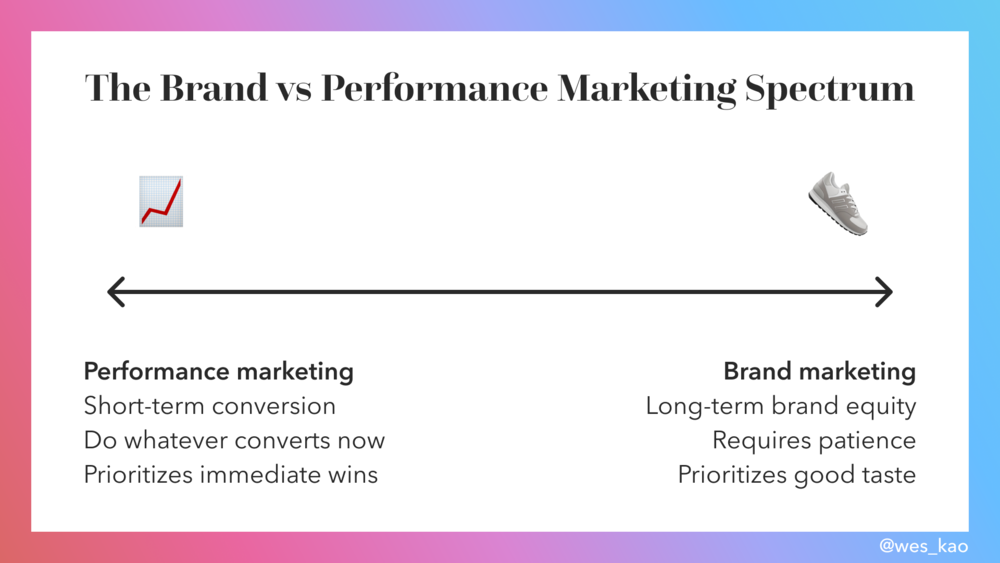I’ve compiled my favorite ways to convey your product’s value prop. These apply to products and brands, but feel free to apply this to people too. These work for job interviews, selling yourself as a consultant, etc.
Read MoreI’ve been thinking about how anytime you have a conversation, there are actually two conversations happening.
There’s the topic. Then there’s the way both people are feeling about the topic. Those two are separate things. The way we're feeling about the topic can completely change the way we talk about it.
Read MoreLast month I published Spiky point of view: Let’s get a little controversial. Since then, I’ve loved reading your replies and Twitter or LinkedIn @ mentions about how the SPOV framework is helping you articulate what you stand for.
One common question I’ve seen: “Is my point of view spiky enough?”
I usually suggest drafting a list of at least 10+ spiky points of view. Some of them will end up being pretty tame. Others are spikier and worth doubling-down on.
Read MorePositioning and messaging is exciting because you’re picking your angle. Of all the ways you could talk about your product, which way should you talk about it?
Even if you’re feeling confident in your brand’s spiky point of view, it’s important to test your story.
At this point, clients will usually ask,
“So how do we know if our story resonates?”
Read MoreWe live in a noisy world. Whichever industry you’re in, there are thousands of other people like you trying to get noticed.
Unless you distinguish yourself, you’ll never get a chance to show how different you actually are.
To stand out, you need to develop what I call a “spiky” point of view.
What is a spiky point of view?
A spiky point of view is a perspective others can disagree with. It’s a belief you feel strongly about and are willing to advocate for. It’s your thesis about topics in your realm of expertise.
Read MoreThere are few philosophical stances that will influence everything about your marketing thereafter.
Deciding to prioritize brand versus performance is one of those things.
I call this the Law of Brand vs Performance Marketing. It states:
All marketing activities are a trade-off between immediate conversion and brand equity.
This means there is a trade-off between brand marketing and performance marketing.
Performance marketing means better short-term conversion, but worse long-term brand equity.
Brand marketing means worse short-term conversion, but better long-term brand equity.
This is worth discussing with your team:
“If you could only prioritize brand or performance, what would you pick?”
Read MoreThe best marketers can turn a bug into a feature. What does this mean? The things you thought you were errors, constraints, or liabilities about your product, could actually become selling points you emphasize.
Read MoreA/B testing costs more than you think.
At first glance, marketing experiments seem free. They’re a data-driven way to validate your assumptions and understand what customers want, before going all in.
But when we talk about the benefits of marketing experiments, we don't usually talk about the costs associated with those experiments. When you factor in the complexity and overhead involved, it's very possible an experiment isn't worth your time.
This is a wake up call for folks who think testing everything is a good idea.
The next time someone asks you to “do a quick test,” think about whether the experiment will generate insights worth the investment.
Read MoreThe best marketers might call themselves marketers... But they are secretly strong in other disciplines.
Over the past 12 years, I’ve been asked many times, “How can I become a better marketer?”
My answer has changed over time. But one thing has stayed constant: only focusing on marketing is not enough.
By all means, read the classics and contemporary work about marketing. If you ONLY do that, though, you’ll back yourself into a corner. Your box will get smaller and smaller.
Instead, get good at adjacent disciplines. The adjacent disciplines will give you the je ne se quois that expands your lateral thinking. They make you a sharper, savvier, more nuanced marketer.
Read More“Don’t try to market to everyone.” By now, this advice is obvious. We know we can’t appeal to everyone.
But what if you feel like your product really is for everyone? Where do you start?
One way to narrow down your focus is to think about your customers as concentric circles on a bullseye. In the center of the bullseye are your core customers. These are people who are die-hard fans, who completely “get it.” They are excited you exist.
Start by marketing to them, then expand outwards. This is especially valuable if you have limited resources and bandwidth.
Read More

